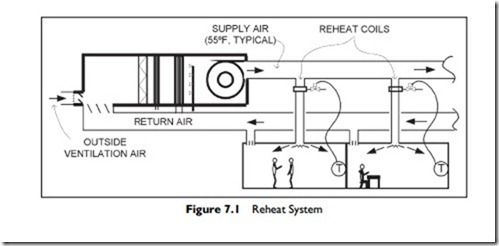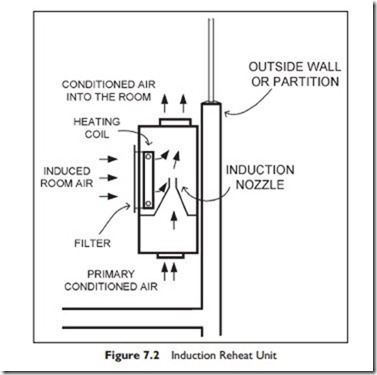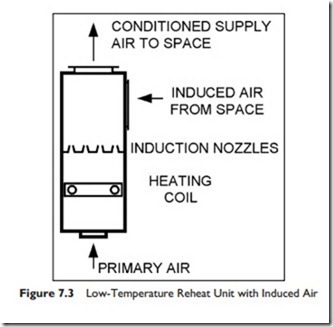Single-Duct, Zoned Reheat, Constant Volume Systems
The reheat system is a modification of the single-zone system. The reheat system permits zone control by reheating the cool airflow to the temperature required for a particular zone. Figure 7.1 shows a reheat system, with ceiling supply diffusers in the space.
A constant volume of conditioned air is supplied from a central unit at a normally, fixed temperature, (typically 55°F). This fixed temperature is designed to offset the maximum cooling load in all zones of the space. If the actual cooling load is less than peak, then the reheat coil provides heat equal to the difference between the peak and actual loads. When heating is required, the heater heats the air above zone temperature to provide heating.
The reheat coil is located close to the zone and it is controlled by the zone thermostat. Reheat coils are usually hot water or electric coils. As noted above, if the reheat coils are hot water, then there can be a problem with leakage.
A reheat system is often used in hospitals, in laboratories, or other spaces where wide load-variations are expected.
When primary air passes quickly over a vent, it draws some room air into the vent. This process is called induction. There are two variations on the reheat system that both use induced room air: the Induction Reheat Unit, shown in Figure 7.2; and the Low-Temperature Reheat Unit with Induced Air shown in Figure 7.3.
The Induction Reheat Unit shown in Figure 7.2 shows the primary supply of air, blown into the unit and directed through the induction
nozzle. The reduced aperture of the nozzle forces the air to speed up and move quickly to the unit exit, into the room. As the primary air passes quickly past the reheat coil, it draws, or induces, air from the room into the unit. The room air passes across the reheat coil and mixes with the primary air.
Units like this are often mounted beneath windows, where they offset any downdraft in cold weather. In addition, even when the air supply is turned “off,” hot water in the coil will still provide some heating.
The second type of induction reheat system, the Low-Temperature Reheat Unit with Induced Air, shown in Figure 7.3, is used where very cold supply air is provided. In some systems, the supply air can be as cold as 40°F. This could create intolerable drafts and serious condensation on the supply outlets. In this system, the primary air is preheated when necessary, but room air is always induced to mix with the primary air to ensure that the flow into the space is not excessively cold.
There are two primary advantages to this system:
e Duct sizing: When the system is designed to use 40°F supply air, ducts can be sized for half the air volume, compared to the ducts required for a 55°F supply-air temperature. This results in a lower installation cost, and a smaller requirement for duct space.
e The small volume of supply air may be exhausted from the room rather than returned to the main cooling system, possibly eliminating the need for return ductwork.
Overall, reheat systems are simple, and initial costs, the costs of design and construction, are reasonable. Reheat systems provide good humidity control, good temperature control, good air circulation, and good air quality.
The problem with all reheat systems is their energy inefficiency, so they are expensive systems to run. Generally, when the load is less than the peak cooling load, the cooling effect and the reheat are working against each other to neutralize their contributions. This means, in a no-load situation, the refrigeration is going at full blast and the reheat is just matching the cooling effect. There are two energy drains for no load! This is not quite as severe as it sounds because the no-load condition is the worst-case scenario, and it only occurs for a relatively small amount of the time.
Overall, though, reheat is energy expensive. As a result, these systems have fallen out of favor in recent times.


